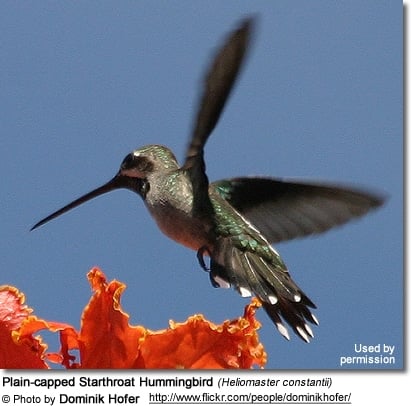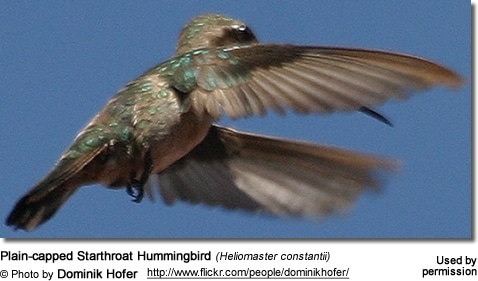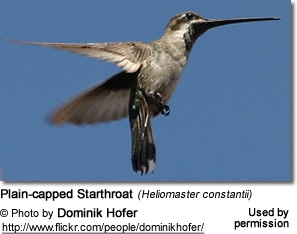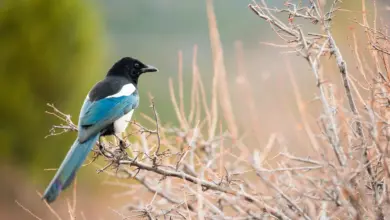Plain-capped Starthroat Hummingbird
The Plain-capped Starthroat Hummingbird (Heliomaster constantii)- also known as Constant’s Starthroat or Pine Starthroat – is a large hummingbird that is native to Mexico and Central America.


Alternate (Global) Names
Spanish: Colibrí Pochotero, Colibrí Estrella Encapotada, Colibrí Picudo, Colibrí Pochotero, Picolargo Coronioscuro … Italian: Gola stellata di Constant, Golastella caposcuro … German: Funkenkehlchen, Funkenkehlkolibri, Funken-Kelchen … Czech: Kolibrík achátový, kolib?ík 0achátový … Danish: Gråbuget Stjernestrube … Finnish: Tummasäiläkolibri … French: Colibri de Constant … Japanese: mujiboushinodofusahachidori, ????????????? … Dutch: Vonkkeelkolibrie … Norwegian: Bronsestjernestrupe … Polish: aksamitek bialowasy, aksamitek bia?ow?sy … Russian: ??????????? ????? … Slovak: medovec bielofúzy … Swedish: Brunhättad stjärnkolibri … Chinese: ??????

Distribution / Range
Plain-capped Starthroats occur in western Mexico (the Sierra Madre Occidentals) to southern Costa Rica (Central America).
They are very rare visitors to the United States at the end of the breeding season (June through September). Specifically, they visit the south-easternmost Arizona, where they have been reported in the Madrean sky islands of the Sierra Madre ranges (Ash Canyon, Madera Canyon, Cave Creek Canyon, Coronado National Memorial and Patagonia) and the Agua Caliente Regional Park in Tucson. There are also reports of them visiting New Mexico. They are not present in the United States every year.
Their breeding territory ranges from central Sonora through northwestern Costa Rica in Central America.
They live in tropical deciduous forests, cottonwood-willow streamside forests, and oak woodland areas in lower to middle elevations.
Subspecies and Distribution
- Heliomaster constantii constantii (DeLattre, 1843) – Nominate Race
- Occurs in El Salvador to southern Costa Rica.
- Heliomaster constantii pinicola (Gould, 1853)
- Found in northwestern Mexico (south to the Mexican state of Jalisco) – vagrants to southwestern USA (Arizona)
- Heliomaster constantii leocadiae (Bourcier and Mulsant, 1852)
- Found in western and southwestern Mexico and western Guatemala
- [Heliomaster constantii surdus] – Proposed race — mostly considered synonym of leocadiae (one and the same)

Description
The Plain-capped Starthroat is one of the larger hummingbirds measuring from 4.3 – 5.5 inches (11 – 14 cm) including beak and tail. The average weight is approximately 0.2 – 0.3 oz (7 – 8 g).
It has a very long, slender, black beak and a slightly notched bronze-green tail with white tips on the outer 3 to 4 pairs of feathers. The wings extend to the tail tip or beyond.
Adults have a dark, mostly metallic bronze upper plumage (crown, back and tail) with a white patch on the back and rump (lower back – above tail). The plumage below is greyish white. He has a metallic violet-red gorget (throat patch) that can look dull blackish in poor light conditions.
It has a dark eye-stripe with a white stripe above and below.
Female
The female resembles the male, but has a slightly less colorful plumage.
Juveniles
Immature birds look like adults but no red on dark gray-brown throat, pale feather edgings on back and head
Nesting / Breeding
Plain-capped Starthroats typically nest from late winter through mid-summer in their breeding territory that stretches from western Mexico to southern Costa Rica.
Hummingbirds are solitary in all aspects of life other than breeding; and the male’s only involvement in the reproductive process is the actual mating with the female. They neither live nor migrate in flocks; and there is no pair bond for this species.
Males court females by flying in a u-shaped pattern in front of them. He will separate from the female immediately after copulation. One male may mate with several females. In all likelihood, the female will also mate with several males. The males do not participate in choosing the nest location, building the nest or raising the chicks.
Females build cup-shaped nest using plant fibers woven together and green moss on the outside for camouflage in a protected location in a shrub, bush or tree. The nests are lined with soft plant fibers, animal hair and feather down, and the structure is strengthened with spider webbing and other sticky material, giving it an elastic quality to allow it to stretch to double its size as the chicks grow and need more room. The nest is typically found on a low, thin horizontal branch.
The average clutch consists of two white eggs, which she incubates alone, while the male defends his territory and the flowers he feeds on. The young are born blind, immobile and without any down.
The female protects and feeds the chicks with regurgitated food (mostly partially-digested insects since nectar is an insufficient source of protein for the growing chicks). She pushes the food down the chicks’ throats with her long bill directly into their stomachs.
The chicks are brooded only the first week or two, and left alone even on cooler nights after about 12 days – probably due to the small nest size. The chicks leave the nest when they are about 20 days old.
Diet / Feeding
The Plain-capped Starthroat Hummingbirds primarily feed on nectar taken from a variety of brightly colored, scented small flowers of trees, herbs, shrubs and epiphytes. They favor flowers with the highest sugar content (often red-colored and tubular-shaped) and seek out, and aggressively protect, those areas containing flowers with high energy nectar.They use their long, extendible, straw-like tongues to retrieve the nectar while hovering with their tails cocked upward as they are licking at the nectar up to 13 times per second. Sometimes they may be seen hanging on the flower while feeding.
Many native and cultivated plants on whose flowers these birds feed heavily rely on them for pollination. The mostly tubular-shaped flowers actually exclude most bees and butterflies from feeding on them and, subsequently, from pollinating the plants.
They may also visit local hummingbird feeders for some sugar water, or drink out of bird baths or water fountains where they will either hover and sip water as it runs over the edge; or they will perch on the edge and drink – like all the other birds; however, they only remain still for a short moment.
They also take some small spiders and insects – important sources of protein particularly needed during the breeding season to ensure the proper development of their young. Insects are often caught in flight (hawking); snatched off leaves or branches, or are taken from spider webs. A nesting female can capture up to 2,000 insects a day.
Males establish feeding territories, where they aggressively chase away other males as well as large insects – such as bumblebees and hawk moths – that want to feed in their territory. They use aerial flights and intimidating displays to defend their territories.
Species Research by Sibylle Johnson





